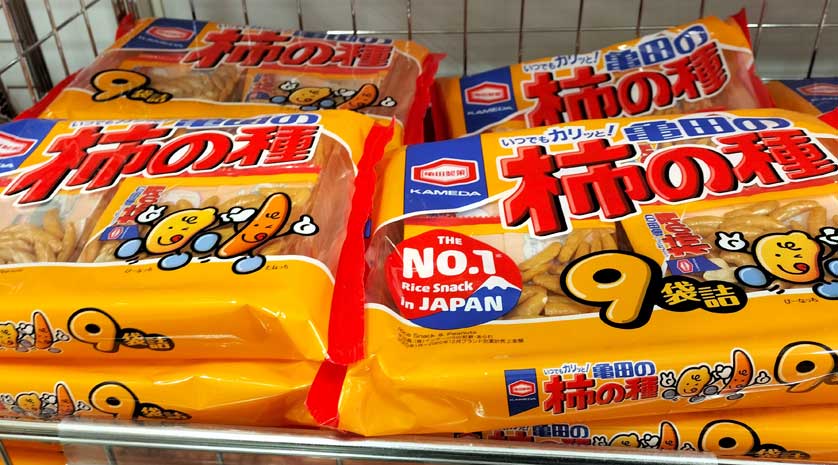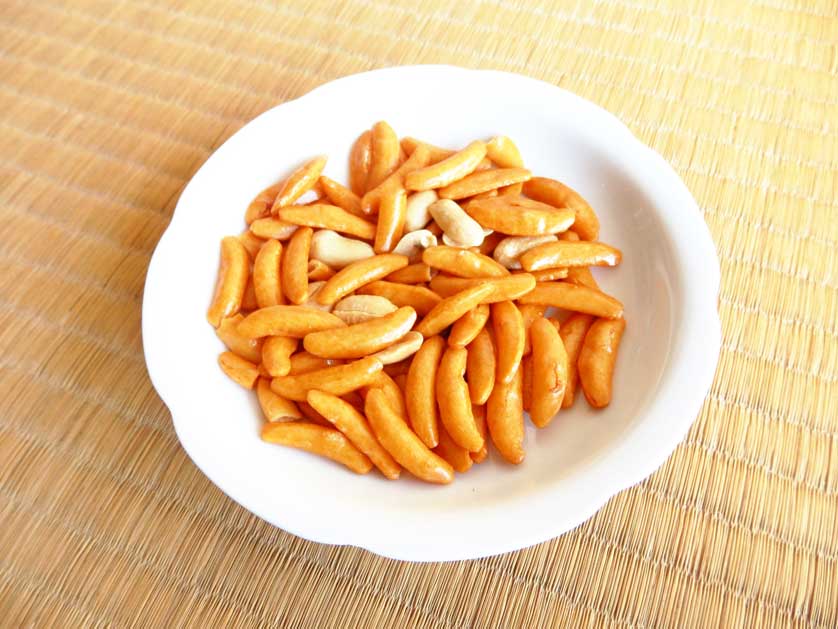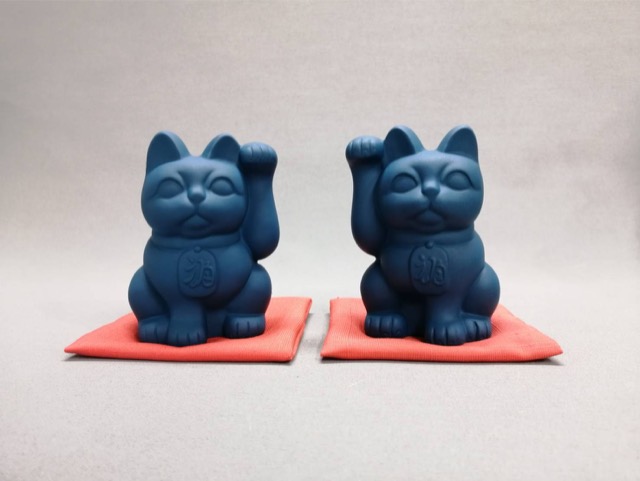Furikake Tsukudani Rice Topping Kinshobai 錦松梅
The term tsukudani encompasses a wide range of side dishes and rice toppings that have one thing in common: the ingredients are all prepared by simmering or boiling in soy sauce and mirin. Mirin is a Japanese "rice wine" (that is, an alcoholic liquid made by fermenting rice) with a low alcohol and high sugar content. Mirin is widely used in Japanese cooking.
The various types of tsukudani are then defined by their ingredients. The most common range from kombu (kelp) to nori and other seaweed to small fish like smelt and sand lance to small clams to various types of shredded vegetables to thinly sliced beef. There is even tsukudani made of grasshoppers. Yes, grasshoppers can be absolutely delicious and make for a crispy tsukudani.
The taste of the various tsukudani depends on the source materials used but they are all more or less sweet and spicy.
 |
| Kinshobai |
Tsukudani made of larger items like sand lance or smelt fish are eaten as a side dish to traditional Japanese meals or served as part of a bento box. They are also an integral part of Osechi-ryori, the traditional Japanese New Year's meals.
Tsukudani made of smaller or shredded materials however are most commonly used as rice toppings. Placed on top of a full bowl of rice, they give the rice a strong additional flavor. Those rice toppings are called furikake in Japanese.
The simmering or boiling of the source materials in soy sauce and mirin preserves the tsukudani. They stay good for months.
 |
| Traditional tsukudani store in Yanaka, Tokyo |
History of Tsukudani
There are a number of theories on the history of tsukudani. The most prevailing is this one…
In the early days of the Edo Period (1603 - 1868), Shogun Tokugawa Ieyasu told master fisherman Magoemon Mori to invite skilled fishermen to live in the newly reclaimed estuaries at the mouth of the Sumida Rider in Edo (now Tokyo). Mori invited fisher folks from Tsukuda Village in Osaka. Those fishermen moved to an island close to the Edo shore which soon became known as Tsukudajima (Tsukuda Island). They brought with them the custom of cooking small fish in salt and soy sauce for preservation as a reliable food resource in times of bad weather and for longer fishing trips.
They sold their surplus of preserved little fish on the Edo markets where they became known as Tsukudani - named after Tsukuda Island.
The preserved fish became very popular and soon, other folks started experimenting. Replacing the salt with mirin, using other ingredients. People took those tsukudani as convenient travel food to regions all over Japan where the locals started to get their own ideas on tsukudani, using their local ingredients. Thus, the wide variety of tsukudani today.
The best places to find and buy tsukudani are the traditional tsukudani shops in historical neighborhoods like in Tokyo's Yanaka, close to Nippori and not far from Ueno.
 |
| Kinshobai main store, Yotsuya, Tokyo |
Kinshobai
As varied and tasty as tsukudani are, they have always been a food eaten by everyone - from to the poor to the rich, from the peasant to the shogun, they all liked their basic tsukudani.
In 1932, the Kinshobai Company in Yotsuya, Tokyo set out to introduce their own brand of furikake tsukudani (rice topping tsukudani), aiming to 'carry the flavor of the Edo Period to the present day' (as stated on the company website).
The ingredients of Kinshobai aren't in any way fancy or unusual for a tsukudani. It's the fine-tuned mix of those ingredients that sets Kinshobai apart from common tsukudani.
The ingredients used are soy sauce (produced in-house), dried bonito flakes, sugar, white sesame seeds, kelp (kombu), wood ear mushrooms, pine nuts, shiitake mushrooms, plus a variety of seasonings.
Kinshobai is delicious as rice topping, it can however also be eaten on cold tofu, inside tamagoyaki (Japanese rolled omelettes) and even as a spread on bread.
 |
| Bowl of kinshobai |
How Kinshobai Began
In the early 1900s, a gourmet named Kyokuo, descendant of the old Kakegawa samurai clan, travelled the country, searching out the best foods in all the different regions.
Kyokuo had been brought up eating plain rice with dried bonito flakes on top for his school lunch every day. He hated the banality and boredom of that lunch and thought of a way to create a somewhat simple but refined and tasty rice topping that he himself would really enjoy.
He eventually came up with a mix of ingredients and spices that he named Kinshobai after his two favored bonsai trees.
The name Kinshobai (錦松梅) is a combination of Nishiki Matsu 錦松 (a highly prized bonsai tree based on a mutant species of black pine only found along the coast near Takamatsu City, Shikoku) and Ume 梅, the Japanese apricot whose trees are very popular as bonsai.
The wonders of Japanese kanji pronunciation then turn the combined names Nishiki Matsu and Ume into Kinshobai.
 |
| Kinshobai rice topping in Arita ware bowl |
Kyokuo never intended to make Kinshobai a business. He enjoyed his creation with his family. His wife was a master of ikebana (traditional flower arrangement), so he also shared his Kinshobai with her disciples. After he presented the wedding party of a grand company president with his Kinshobai, the taste, aroma and texture of his creation became so popular that he eventually could be persuaded to produce Kinshobai for a larger public.
In 1932, Kyokuo started the Kinshobai Company in the Yotsuya neighborhood of Tokyo where it still resides.
The company still sells only one product - the original Kinshobai furikake tsukudani. Coming, if you wish, in quite luxurious Arita porcelain.
 |
| Kinshobai offered in Spring season Arita porcelain bowl |
Luxury Gourmet Segment
Its unique aroma and taste aside, what sets Kinshobai apart from common tsukudani is the company's marketing. Besides its main store in Yotsuya, Tokyo the company operates a network of shops all over Japan. You find a Kinshobai shop in almost every prefecture, always placed inside the most prestigious department stores.
There, Kinshobai is sold in its most basic form, of course, in the typical 60 gram package.
But also on offer and most prominent are the combinations of Kinshobai and Arita ware porcelain. Kinshobai should be kept in a dry place away from direct sun light. Nothing would serve this purpose better than a colorful, hand-painted container made by the traditional kilns of Arita, Saga Prefecture. Arita ware is one of the finest and most famous porcelains made in Japan.
Many customers buy the combination Kinshobai / Arita ware as a gift to be presented at special occasions. What could be more refined and traditional Japanese than "the flavor of Edo" in one of the country's best porcelains? A gift worthy an Edo nobleman with excellent taste.
You can buy Kinshobai in basic packs as well as in a number of Arita ware porcelain containers directly from Goods From Japan.
Store the Kinshobai at room temperature away from direct sunlight.
 |
| Basic 60g pack |
Buy Kinshobai from Japan
Goods from Japan offers a variety of Japanese foodstuffs and ingredients.
Purchase a range of Japanese food from GoodsFromJapan.
Kinshobai in a pack (Tsukudani Furikake 60g)
 |
| Kinshobai shop in a Japanese department store |
Related
Aizuwakamatsu Hand Painted Candles
by Johannes Schonherr
 |
| Arita ware at a Kinshobai shop |
 |
| Kinshobai main store, Yotsuya, Tokyo |
© GoodsFromJapan.com










